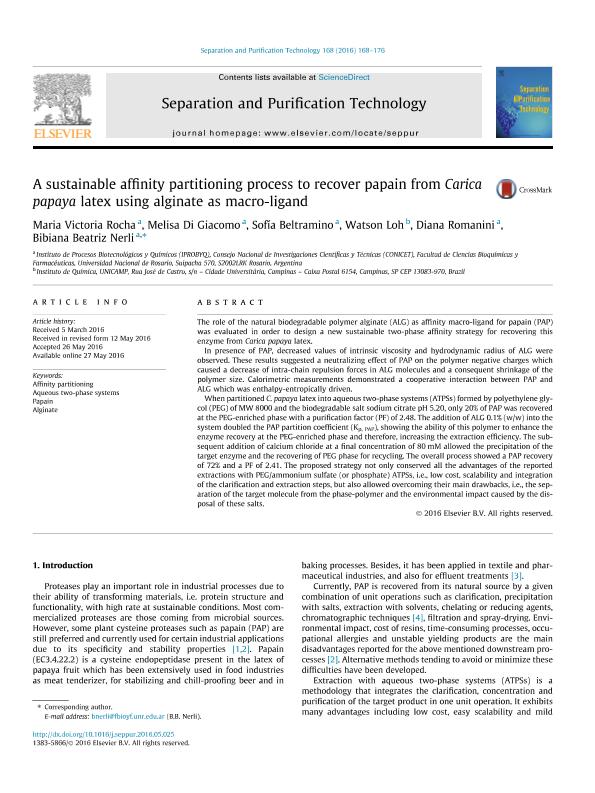Mostrar el registro sencillo del ítem
dc.contributor.author
Rocha, María Victoria

dc.contributor.author
Di Giacomo, Melisa

dc.contributor.author
Beltramino, Sofia
dc.contributor.author
Loh, Watson
dc.contributor.author
Romanini, Diana

dc.contributor.author
Nerli, Bibiana Beatriz

dc.date.available
2018-07-19T17:35:59Z
dc.date.issued
2016-08
dc.identifier.citation
Rocha, María Victoria; Di Giacomo, Melisa; Beltramino, Sofia; Loh, Watson; Romanini, Diana; et al.; A sustainable affinity partitioning process to recover papain from Carica papaya latex using alginate as macro-ligand; Elsevier Science; Separation and Purification Technology; 168; 8-2016; 168-176
dc.identifier.issn
1383-5866
dc.identifier.uri
http://hdl.handle.net/11336/52653
dc.description.abstract
The role of the natural biodegradable polymer alginate (ALG) as affinity macro-ligand for papain (PAP) was evaluated in order to design a new sustainable two-phase affinity strategy for recovering this enzyme from Carica papaya latex. In presence of PAP, decreased values of intrinsic viscosity and hydrodynamic radius of ALG were observed. These results suggested a neutralizing effect of PAP on the polymer negative charges which caused a decrease of intra-chain repulsion forces in ALG molecules and a consequent shrinkage of the polymer size. Calorimetric measurements demonstrated a cooperative interaction between PAP and ALG which was enthalpy-entropically driven. When partitioned C. papaya latex into aqueous two-phase systems (ATPSs) formed by polyethylene glycol (PEG) of MW 8000 and the biodegradable salt sodium citrate pH 5.20, only 20% of PAP was recovered at the PEG-enriched phase with a purification factor (PF) of 2.48. The addition of ALG 0.1% (w/w) into the system doubled the PAP partition coefficient (Kp, PAP), showing the ability of this polymer to enhance the enzyme recovery at the PEG-enriched phase and therefore, increasing the extraction efficiency. The subsequent addition of calcium chloride at a final concentration of 80 mM allowed the precipitation of the target enzyme and the recovering of PEG phase for recycling. The overall process showed a PAP recovery of 72% and a PF of 2.41. The proposed strategy not only conserved all the advantages of the reported extractions with PEG/ammonium sulfate (or phosphate) ATPSs, i.e., low cost, scalability and integration of the clarification and extraction steps, but also allowed overcoming their main drawbacks, i.e., the separation of the target molecule from the phase-polymer and the environmental impact caused by the disposal of these salts.
dc.format
application/pdf
dc.language.iso
eng
dc.publisher
Elsevier Science

dc.rights
info:eu-repo/semantics/openAccess
dc.rights.uri
https://creativecommons.org/licenses/by-nc-sa/2.5/ar/
dc.subject
Affinity Partitioning
dc.subject
Alginate
dc.subject
Aqueous Two-Phase Systems
dc.subject
Papain
dc.subject.classification
Otras Ciencias Químicas

dc.subject.classification
Ciencias Químicas

dc.subject.classification
CIENCIAS NATURALES Y EXACTAS

dc.title
A sustainable affinity partitioning process to recover papain from Carica papaya latex using alginate as macro-ligand
dc.type
info:eu-repo/semantics/article
dc.type
info:ar-repo/semantics/artículo
dc.type
info:eu-repo/semantics/publishedVersion
dc.date.updated
2018-07-18T20:43:30Z
dc.journal.volume
168
dc.journal.pagination
168-176
dc.journal.pais
Países Bajos

dc.journal.ciudad
Amsterdam
dc.description.fil
Fil: Rocha, María Victoria. Consejo Nacional de Investigaciones Científicas y Técnicas. Centro Científico Tecnológico Conicet - Rosario. Instituto de Procesos Biotecnológicos y Químicos Rosario. Universidad Nacional de Rosario. Facultad de Ciencias Bioquímicas y Farmacéuticas. Instituto de Procesos Biotecnológicos y Químicos Rosario; Argentina
dc.description.fil
Fil: Di Giacomo, Melisa. Consejo Nacional de Investigaciones Científicas y Técnicas. Centro Científico Tecnológico Conicet - Rosario. Instituto de Procesos Biotecnológicos y Químicos Rosario. Universidad Nacional de Rosario. Facultad de Ciencias Bioquímicas y Farmacéuticas. Instituto de Procesos Biotecnológicos y Químicos Rosario; Argentina
dc.description.fil
Fil: Beltramino, Sofia. Consejo Nacional de Investigaciones Científicas y Técnicas. Centro Científico Tecnológico Conicet - Rosario. Instituto de Procesos Biotecnológicos y Químicos Rosario. Universidad Nacional de Rosario. Facultad de Ciencias Bioquímicas y Farmacéuticas. Instituto de Procesos Biotecnológicos y Químicos Rosario; Argentina
dc.description.fil
Fil: Loh, Watson. State university of Campinas; Brasil
dc.description.fil
Fil: Romanini, Diana. Consejo Nacional de Investigaciones Científicas y Técnicas. Centro Científico Tecnológico Conicet - Rosario. Instituto de Procesos Biotecnológicos y Químicos Rosario. Universidad Nacional de Rosario. Facultad de Ciencias Bioquímicas y Farmacéuticas. Instituto de Procesos Biotecnológicos y Químicos Rosario; Argentina
dc.description.fil
Fil: Nerli, Bibiana Beatriz. Consejo Nacional de Investigaciones Científicas y Técnicas. Centro Científico Tecnológico Conicet - Rosario. Instituto de Procesos Biotecnológicos y Químicos Rosario. Universidad Nacional de Rosario. Facultad de Ciencias Bioquímicas y Farmacéuticas. Instituto de Procesos Biotecnológicos y Químicos Rosario; Argentina
dc.journal.title
Separation and Purification Technology

dc.relation.alternativeid
info:eu-repo/semantics/altIdentifier/doi/https://dx.doi.org/10.1016/j.seppur.2016.05.025
dc.relation.alternativeid
info:eu-repo/semantics/altIdentifier/url/https://www.sciencedirect.com/science/article/pii/S1383586616305032
Archivos asociados
